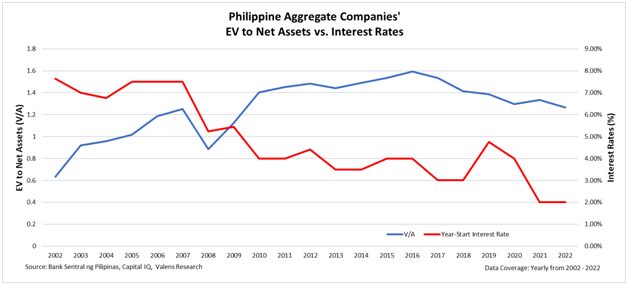PH Monday Macro: Rate hikes are creating opportunities in the market

Currently, we are in a quantitative tightening environment where the central bank is increasing interest rates to control elevated levels of inflation. It does this because one of its primary objectives is to keep inflation low and stable enough for balanced and sustainable economic growth.
While we directly feel the effects of changes in interest rates through changes in prices of goods and services, as well as in changes in returns from investments, there’s a way changes in interest rates affect us indirectly.
Today, we will talk about the relationship between interest rates and market pricing of companies.
Philippine Markets Daily:
The Monday Macro Report
Powered by Valens Research
Interest rates influence the business cycle and economic growth of a country. To an extent, It could either create a bubble or mute economic activity.
When the Philippine economy contracted due to the pandemic, the Bangko Sentral ng Pilipinas (BSP) switched to a crisis intervention policy where it cut rates and injected money supply into the system in order to stimulate the economy. However, the drawback of attempting to raise economic activity is a higher level of inflation that usually follows.
In 2021, the Philippines started to open up by easing ECQ restrictions. With more money in consumers’ pockets, this drastically increased the demand for goods. However, supply was not able to keep up with demand. That made it possible for suppliers of goods to increase their prices.
Interest rates play a key role in investments as well. We normally see the impact directly on bank deposits, time deposits, and treasury bonds that retail investors have access to. An indirect way of seeing the impact of interest rates is in the stock market, particularly because of company valuations.
Specifically, when we calculate a firm’s intrinsic value, we use some cash or aggregate value of the firm in the numerator and a discount rate influenced by the interest rate in the denominator. So when interest rates decline, companies end up being priced at a higher valuation, all else constant.
Hence, interest rates and company valuations more often than not trend in opposite directions.
Take a look…

The data set in the chart is comparing the start of the year overnight Reverse Repurchases Rate (RRP) contrasted with the aggregate Enterprise Value to Net Assets ratio (or “V/A”) over the years.
The RRP (or “repo”) is used as a variable because the repo market is heavily utilized by the central bank to conduct and support monetary policy implementation.
Furthermore, it plays a crucial role in facilitating money supply in the system. When RRP rates are high, there is less money supply. When RRP rates are low, there is more money supply. From this, the more money supply, it pushes the probability of a higher rate of inflation and vice versa.
In comparison, the V/A is the measurement of Enterprise Value in relation to its Net Asset. This ratio is trying to show the discounted premium that the market is pricing for companies.
Presented above, we could see the divergence between V/A (EV to Net Assets) and interest rates. As interest rates fall, company valuations rise. In 2009, when the BSP started to cut rates, company valuations gradually inched up. Then, in 2019, the central bank raised rates and company valuations started to fall.
In this data set, the only time RRP and the V/A ratio moved towards one direction in parallel was during the 2008 financial crisis when investors were worried about financial contagion. The central bank cut rates to help mitigate any crisis as investors became concerned about the economy and started to lower expectations for the performance of Philippine companies.
The BSP has been raising rates for a while now to combat inflation. This means there will continue to be potential buying opportunities for investors.
About the Philippine Markets Newsletter
“The Monday Macro Report”
When just about anyone can post just about anything online, it gets increasingly difficult for an individual investor to sift through the plethora of information available.
Investors need a tool that will help them cut through any biased or misleading information and dive straight into reliable and useful data.
Every Monday, we publish an interesting chart on the Philippine economy and stock market. We highlight data that investors would normally look at, but through the lens of Uniform Accounting, a powerful tool that gets investors closer to understanding the economic reality of firms.
Understanding what kind of market we are in, what leading indicators we should be looking at, and what market expectations are will make investing a less monumental task than finding a needle in a haystack.
Hope you’ve found this week’s macro chart interesting and insightful.
Stay tuned for next week’s Monday Macro report!
Regards,
Angelica Lim
Research Director
Philippine Markets Newsletter
Powered by Valens Research
www.valens-research.com




